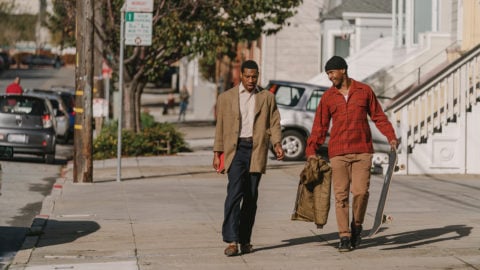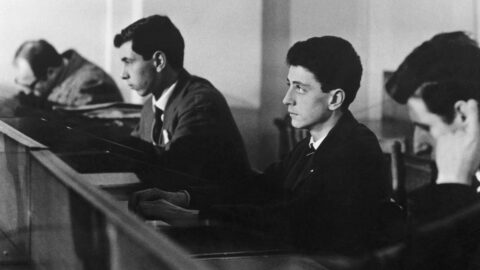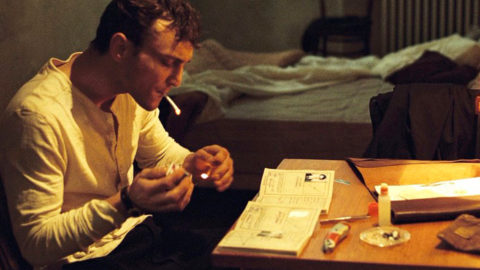Labor of Love: In the Aisles, Il Posto, and The Last Black Man in San Francisco
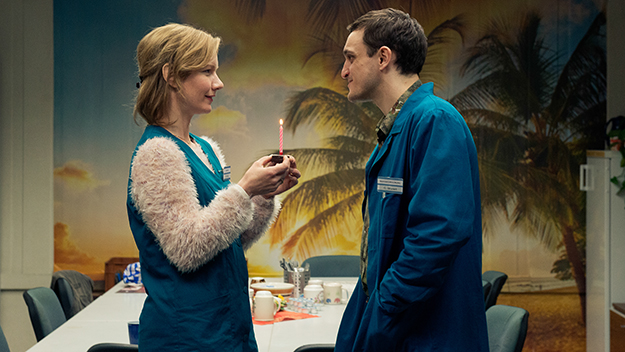
In the Aisles (Thomas Stuber, 2018)
To look closely at the overlooked, and to part the scrim of familiarity that makes us dismiss everyday things as banal, is one of art’s noblest purposes. Thomas Stuber’s In the Aisles (2018) trains its patient gaze on what you might expect to be a mind-numbing job in a soul-killing environment—stacking shelves in a huge, Costco-like wholesale market—and reveals grace, dignity, and submerged but powerful currents of emotion. Based on a short story of the same name by Stuber’s frequent collaborator Clemens Meyer, the film fleshes out the skeletal prose but preserves the spare, understated style in its laconic dialogue, austere images, and deadpan performances.
Christian (Franz Rogowski) is a new hire assigned to the Beverages aisle, where he learns the ropes from the gruff, burly veteran Bruno (Peter Kurth). For the first thirty minutes of the film, Christian is virtually mute, and Rogowski channels Buster Keaton with his expressive reticence, shy curiosity, and subtle physical comedy as he wrestles with pallet jacks and makes his first, bumbling efforts to drive a forklift. Peering through the shelves, he is smitten with Marion (Sandra Hüller), the blonde who works the next aisle over in Sweet Goods. Christian bonds with Bruno during illicit smoke breaks and flirts with Marion over cups of vending-machine coffee and just-expired chocolate cake swiped from the dumpster. But his gentleness is shadowed by murky hints of a less peaceful past: he is covered from neck to wrist in densely-inked tattoos, with black and white pit bulls snarling at each other on his shoulder blades; and one day some rowdy, low-life friends turn up at the store to mock and threaten his new respectability.
Leipzig, Stuber’s hometown, appears as a world of desolate parking lots, humming autobahns, and snowy fields, pervaded by a climate of loneliness. Christian rides home after his night shift on an empty bus and lives in a bleak concrete high-rise. Marion is trapped in an abusive marriage to a man we never see, and Bruno harbors an even sadder secret. Much about the characters’ lives is merely hinted at or left ambiguous. With lesser actors these characters might seem sketchy, but Hüller is able to suggest the hidden fragility of a woman who seems wryly confident, and Kurth’s presence has the melancholy weight of an industrial ruin. As he proved in Christian Petzold’s Transit (2018), Rogowski is one of those actors who brings an effortless interiority to the screen, so that his presence always feels intimate even when his characters are elusive.
The glimpses of these people’s unloved homes and joyless personal lives accentuate the oddly idyllic quality of the market where they work. Vast and windowless, it is a world unto itself, encompassing “the Sea,” a seafood section where fish in an overcrowded tank writhe like lost souls, and “Siberia,” a frost-befogged freezer where Christian and Marion share an Eskimo kiss, as well as a break room decorated with a palm tree and a tropical sunset. The easy-going night shift manager, Klaus, shakes hands with each of the employees as they leave at the end of the shift, and floods the store with classical music (“Welcome to the night, colleagues,” he says over the loudspeaker before cueing up Bach’s “Air on the G String”). The gliding ballet of machines and the orderly categories of products (a middle-aged co-worker recites an encyclopedic list of pasta varieties) create a mood of serene purposefulness.
These scenes recall nothing so much as Trash Dance (2012), Andrew Garrison’s sublime documentary about the choreographer Allison Orr’s creation of a dance performance for Austin’s sanitation workers, who reveal the pride, skill, and grace in their taken-for-granted labor. Mastering the light touch and meticulous timing required to manage a forklift is Christian’s route to salvation from the bleary, wasted chaos of his former life, into which he briefly slips back. This idea may seem romantic, and the film favors the lyrically stylized over the documentary in its static, symmetrical compositions, rhythmic editing, and atmospheric, painterly use of artificial light. But there is something relevant and revelatory, too, in this vision of the workplace. Seeing how the staff becomes a family—whether cutting up at a Christmas party or soberly attending a funeral for one of their number—it is easy to understand how the loss of large employers in de-industrialized areas guts communities, whether in former East Germany or Ohio. The film’s political subtext is never stressed, but it is hidden in plain view, like the poetry within the mundane. A final epiphany reveals that the hydraulics of the forklift make a sound like the ocean.
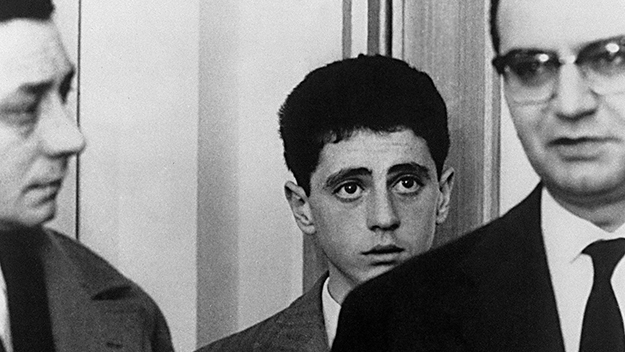
Il Posto (Ermanno Olmi, 1961)
Ermanno Olmi’s Il Posto (The Job) also ends with a swelling noise, but here it is the repetitive grinding of a mimeograph machine, a sound that suggests the endless succession of identical days awaiting Domenico (Sandro Panseri), a very young man who has just earned his place as a clerk in a company that promises lifetime employment. Tellingly, we never know what the company makes or does, or what exactly the staff do. They push pencils, shuffle papers, sort mail, make copies, type letters. Olmi’s second feature quietly, often hilariously, but ruthlessly exposes modern white-collar employment as an absurd purgatory (By contrast, Olmi’s best known film, the hypnotically beautiful Tree of the Wooden Clogs [1978], presents the ceaseless labors of 19th-century peasants in Bergamo—husking and grinding corn, spinning yarn and washing clothes, planting tomatoes and scything hay—as reverent rituals).
In the world of Italy’s postwar economic boom, the shy Domenico is less a go-getter than a sacrificial lamb. Panseri, who like many of Olmi’s actors was non-professional, is touching because he is so transparent and defenseless, his huge calf eyes betraying every feeling; his face constantly stirred by anxiety, embarrassment, uncertainty, amusement. He comes into Milan to join a pool of potential recruits subjected to a battery of psychological and aptitude tests, which range from math problems to physical exams to excruciatingly personal questions. Spotting the beautiful Antonietta, a fellow recruit (Loredana Detto, another non-professional who would later marry Olmi), he is consumed with blushing ardor, showering her with yearning glances. But while she is friendly, his workplace crush fares less well than Christian’s in In the Aisles; after they are placed in different departments, he loses sight of her, lacking the courage to pursue his desires. A New Year’s Eve workers’ party he attends in hopes of seeing her unfolds as a comic nightmare as he arrives unfashionably early and sits alone sporting a cardboard boater. But by the end of the evening, he is swept up in a giddy crowd, apparently having the time of his life.
The balanced, non-judgmental tone is typical of Olmi. Il Posto is clear in its critique of materialism and the corporate mindset, but never heavy-handed about it. The washing machines and stylish clothes that Domenico and Antonietta gaze at in shop windows represent the lure of prosperity that is sucking them into a life of desiccating wage-slavery. On the other hand, who can blame a young man who sleeps in the kitchen of his family’s cramped apartment in a shabby suburb for wanting a better life? And the black and white cinematography, with its neorealist candor and freshness, bestows a certain beauty even on drab offices and crowded cafeterias. A pivotal moment comes with the implied suicide of an employee; where the co-workers of In the Aisles are grief-stricken at similar turns of events, those of Il Posto compete pettily over who gets to move up into the dead man’s desk. Yet there are no villains, any more than there are heroes; Olmi’s treatment of his characters is understanding in the most comprehensive sense: at once compassionate and dispassionate. The humanism that defines his oeuvre (the subject of a retrospective at Film at Lincoln Center, June 14–26) is needed now more than ever, and is amply supplied by Stuber’s new film, which treats its characters with clear-eyed tenderness.
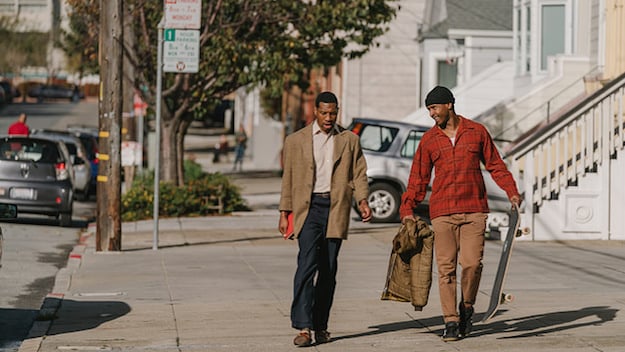
The Last Black Man in San Francisco (Joe Talbot, 2019)
Unabashed love for its characters is one of the many virtues of the enchanting The Last Black Man in San Francisco (2019). It too is the story of a young man seeking a harbor; here it is not a job but a house that promises a sense of purpose and belonging to someone adrift. Debuting director Joe Talbot co-wrote the story and screenplay inspired by the life of his friend Jimmie Fails, who stars as a fictionalized version of himself. Fails spent his early years in a large Victorian house in the Fillmore, a neighborhood once known as the “Harlem of the West” before most of the black residents, including his family, were displaced. Jimmie’s years of shuffling through public housing, group homes, and occasional homelessness enshrined the Fillmore house—which according to family legend had been built by Fails’s grandfather as a lost Eden. In the movie, Jimmie haunts the old home, touching up the trim and weeding the garden, much to the exasperation of the current (white) owners. When they in turn lose the house, he decides to move in and occupy the place with his best friend, Mont (Jonathan Majors): an aspiring playwright, sketch artist, fishmonger, eccentric, and all-around mensch. It is a quixotic gesture that you know will end in heartbreak but cannot help rooting for. Romantic impracticality is the keystone of San Francisco, a city built on a foggy, chilly, wind-scoured, but ravishingly beautiful spit of land, much of it more vertical than horizontal. Something in the dreaminess of the luminous fog and the bracing scent of eucalyptus nurtures fantastic obsessions (see: Vertigo).
The film wears its heart, and its San Francisco chauvinism, on its sleeve, devoting much time to rapturous scenes of the friends skateboarding around the city, tableaux of street life, and cameos by flamboyant oddballs. While the gorgeous house in Fillmore may be the center of the plot, the film is as much about the neighborhood of Hunter’s Point, a weedy area on the edge of the Bay, where a humbler wood-frame house belonging to Mont’s grandfather (Danny Glover) offers an alternate image of rootedness. The story’s political context—gentrification, predatory real estate, the erasure of African American history, and the neglect of black communities—is ever-present, but never steals focus from the personal. Jimmie’s friendship with Mont is a passionate platonic love story elevated by the attention lavished on their odd-couple personalities. There is yet another thread here about the way young black males are forced into stereotyped roles; Mont’s fascination with the cluster of tough guys always hanging out and trash-talking outside his house, and his determination to observe, appreciate, and immortalize them, is his own quixotic, riskily open-hearted gesture.
All these films are about “gentle people” (of the kind promised by the John Phillips song “San Francisco (Be Sure to Wear Flowers in Your Hair),” heard in The Last Black Man), struggling to fit into a world that often casually and impersonally crushes them. Different in style and feeling, they all share an essential, animating warmth, which can become a principle, articulated in a scene that Talbot says has been singled out by many early viewers of the film. On a bus, Jimmie overhears two white girls snottily complaining that the city is overpriced and dead, and sets them straight: “You don’t get to hate San Francisco,” he insists. “You don’t get to hate it unless you love it.”
Imogen Sara Smith is the author of In Lonely Places: Film Noir Beyond the City and Buster Keaton: The Persistence of Comedy, and has written for The Criterion Collection and elsewhere. Phantom Light is her regular column for Film Comment.



